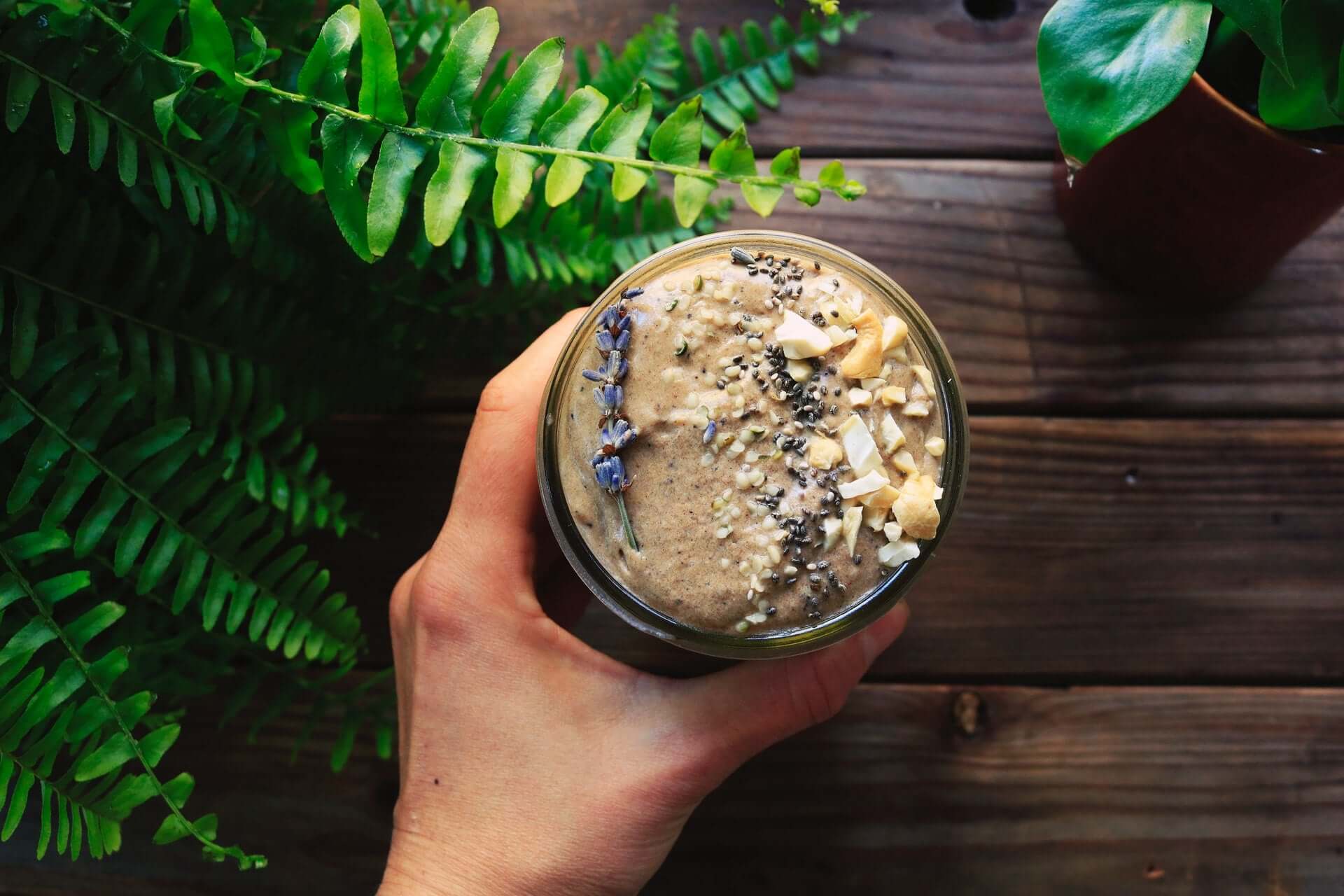
Inhaltsverzeichnis
The perfect smoothie - a guide
Creamy, nutrient-rich, refreshing—that's what every smoothie should be, right? Smoothies are incredibly versatile, quick to make, and you can include a whole host of healthy ingredients. But where do I get started? What should I add? How do I keep my smoothie from being too watery? What should the ratio of solid to liquid ingredients be? This guide will help you on your way to the perfect smoothie.
The Smoothie Guide for your perfect smoothie
1. Liquid, but not It should be watery
If you use water as a liquid base for smoothies, they quickly become watery (who would have thought? 😉). Therefore, I would recommend using plant-based milk alternatives. Plant drinks like almond or oat milk make smoothies creamy and strong. Coconut milk It has a strong flavor of its own, making it especially suitable for "tropical" smoothies. Its creaminess is unbeatable!
Also Coconut water I occasionally use it in my smoothies. Coconut water is lower in fat than coconut milk, has the typical coconut flavor, and is a great thirst quencher! Unfortunately, coconut water is quite expensive. You should also make sure that there are other ingredients in the smoothie that provide the necessary creaminess (z.B. avocado or banana).
Recommended quantity: 200-250 ml (more if necessary)
2. Bring frozen fruit
Smoothies made with only fresh fruit simply taste different than smoothies made with frozen fruit. The smoothie is made frozen fruit It's pleasantly cool (which is especially desirable in the summer months), and the texture of the drink also changes. The cold fruit adds richness to the smoothie and also contributes to its creaminess. You can use whatever you like: berries of any kind, pineapple, bananas, apples, oranges, peaches, mango, nectarines...
These days, the frozen fruit we find in the freezer section of supermarkets is usually just as nutritious as fresh fruit. So there's no need to sacrifice quality or taste!
You don’t necessarily have to buy frozen fruit in the store, you can also freeze yourselfFor this reason, frozen bananas used. Because you can easily freeze them yourself: Peel the ripe banana, quarter it, and place it in a freezer-safe bag. Freezing is a great solution, especially if you have leftover ripe bananas and don't want to bake banana bread with them again. The bananas can be used at a later date without going bad.
If you don’t have frozen fruit on hand, ice cubes a great way to make your smoothie cool, thick and creamy.
Recommended quantity: approx. 150 g/1-2 handfuls
3. Vegetables must not be missing
Smoothies that contain only fruit can be quite calorie-dense. Fruit naturally contains a lot of sugar. Adding vegetables adds even more valuable vitamins and nutrients to the drink. You usually can't even taste the vegetables.
Because the sweet taste of the smoothie still dominates in the end, even children or other vegetable-haters are not afraid of smoothies. I, too, sometimes struggle with getting enough green vegetables. Green smoothies have been a great way for me to incorporate more vegetables into my diet.
Here are some vegetables you can add to your smoothie (please not all at once – we don't want to turn it into a cold vegetable soup...):
Recommended quantity: 1-2 large handfuls

Photo by Jan Sedivy on Unsplash
4. Add filling ingredients
Not all smoothies are meant to replace entire meals, but sometimes that's exactly what you want: a smoothie that keeps you full for longer. This requires rich and satisfying ingredients. For example, you can use these ingredients:
- oatmeal (The oats may make your smoothie drier and more “crumbly.” I recommend soaking the oats for 5 to 10 minutes in a little water or the plant-based milk you’re using.)
- Nut butter (Peanut butter, cashew butter, almond butter, etc. 1-2 tablespoons are sufficient)
- avocado (makes the smoothie nice and creamy, almost like a milkshake! – a quarter to half an avocado is common)
Many recipes call for protein powder to help fill you up. But if you're not a fan of protein powder, you can use these ingredients instead:
- Silken tofu (It may sound strange at first, but silken tofu makes the smoothie creamy and rich in protein without changing the taste)
- Chickpeas/White beans (cooked; it's best to start slowly, check the taste and then add more if necessary)
- red lentils (cooked; these lentils become nice and soft when cooked and have a mild flavor; about 100g of raw lentils are sufficient)
Recommended quantity: 100 - 200g, unless otherwise stated above (in brackets)
5. In with the healthy fats
This point goes hand in hand with point 4. Fats also contribute to our feeling full. Unfortunately, there is still a widespread belief that fats are bad and make us fat. However, healthy fats, which consist largely of unsaturated fatty acids, should not be ignored but should be consciously incorporated into our diet. Regarding some fats, such as coconut oil, there is still debate about how healthy these fats actually are.
My favorite fat “resources” include:
- Nut butter (Peanut butter, cashew butter, almond butter, etc.))
- linseed/Chia seeds/Hemp seeds/Sunflower seeds/Pumpkin seeds
- avocado (makes the smoothie nice and creamy, almost like a milkshake! – a quarter to half an avocado is common)
- raw nuts (Cashews, almonds, peanuts, pecans, hazelnuts, walnuts, etc. – here too, it is advisable to soak the nuts in warm water beforehand)
Recommended quantity: 1-2 tbsp, unless otherwise stated above (in brackets)
6. Toppings – for that certain something
“Superfoods” like Spirulina powder, Goji berries or Chia seeds are often used as toppings. It's important to be aware that these products often come from far away and are therefore not always sustainable. Here, you can focus on regionality and careful handling wherever possible.
Spices can also serve as a topping! Spicesthat I like to mix into my smoothies are Cinnamon and GingerThose who are brave can also use cloves, nutmeg, cardamom, or turmeric (be careful with the dosage).
Also Dates I love them (about 3-4 pieces) in my smoothies! They add a pleasant sweetness and contribute to a creamy consistency. If you're a chocolate fan, you can cocoa powder or cocoa nibs (1-2 tbsp each) mix in.
Recommended quantity: ½ - 1 tsp, unless otherwise stated above (in brackets)
Your smoothie is ready! Whether you try something new every day or stick with your favorite combo once you've found it is up to you. The general rule is: mix whatever you like. After all, trial and error is better than experimentation. 😋. If you would like some inspiration: Here are three green smoothie recipes for you!

Photo by Ella Olsson on Unsplash
If you would like to learn more about healthy eating, mindfulness or sustainability, take a look here over.



























Leave a comment
This site is protected by hCaptcha and the hCaptcha Privacy Policy and Terms of Service apply.